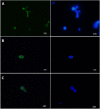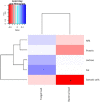Multiple Approaches Detect the Presence of Fungi in Human Breastmilk Samples from Healthy Mothers
- PMID: 29026146
- PMCID: PMC5638952
- DOI: 10.1038/s41598-017-13270-x
Multiple Approaches Detect the Presence of Fungi in Human Breastmilk Samples from Healthy Mothers
Erratum in
-
Author Correction: Multiple Approaches Detect the Presence of Fungi in Human Breastmilk Samples from Healthy Mothers.Sci Rep. 2018 Nov 9;8(1):16829. doi: 10.1038/s41598-018-35165-1. Sci Rep. 2018. PMID: 30410069 Free PMC article.
Abstract
Human breastmilk contains a variety of bacteria that are transmitted to the infant and have been suggested to contribute to gut microbiota development and immune maturation. However, the characterization of fungal organisms in milk from healthy mothers is currently unknown although their presence has been reported in the infant gut and also in milk from other mammals. Breastmilk samples from healthy lactating mothers (n = 65) within 1 month after birth were analyzed. Fungal presence was assessed by different techniques, including microscopy, growth and identification of cultured isolates, fungal load estimation by qPCR, and fungal composition using 28S rRNA gene high-throughput sequencing. In addition, milk macronutrients and human somatic cells were quantified by spectrophotometry and cytometry. qPCR data showed that 89% of samples had detectable levels of fungal DNA, at an estimated median load of 3,5 × 105 cells/ml, potentially including both viable and non-viable fungi. Using different culture media, 33 strains were isolated and identified, confirming the presence of viable fungal species. Pyrosequencing results showed that the most common genera were Malassezia (44%), followed by Candida (19%) and Saccharomyces (12%). Yeast cells were observed by fluorescence microscopy. Future work should study the origin of these fungi and their potential contribution to infant health.
Conflict of interest statement
The authors declare that they have no competing interests.
Figures





References
Publication types
MeSH terms
LinkOut - more resources
Full Text Sources
Other Literature Sources
Medical

